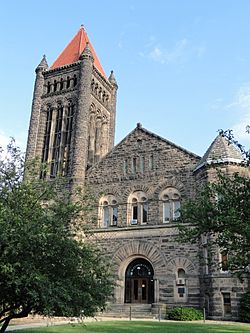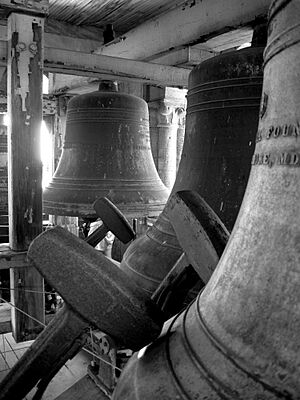Altgeld Hall facts for kids
Quick facts for kids Altgeld Hall |
|
|---|---|

Altgeld Hall in 2011
|
|
| Former names | University Library Law Building |
| General information | |
| Type | educational |
| Architectural style | Richardsonian Romanesque |
| Location | University of Illinois at Urbana–Champaign campus |
| Address | 1409 West Green Street Urbana, Illinois |
| Current tenants | Department of Mathematics Mathematics Library |
| Construction started | June 10, 1896 |
| Completed | December 1, 1897 |
| Owner | University of Illinois at Urbana–Champaign |
| Design and construction | |
| Architect | Nathan Ricker and James McLaren White |
Altgeld Hall is a historic building located at 1409 West Green Street in Urbana, Illinois. It stands on the University of Illinois at Urbana–Champaign (UIUC) campus. This impressive building was constructed between 1896 and 1897.
It was designed by Nathan Ricker and James McLaren White, who worked in the University's architecture department. They used a style called Richardsonian Romanesque, which features strong, heavy stone and round arches. Planning for the building started when John Peter Altgeld was the governor of Illinois.
Altgeld Hall was first used as the University Library. Over the years, it had big additions in 1914, 1919, 1926, and 1956. From 1927 to 1955, it was home to the College of Law. Since 1955, the Department of Mathematics and the Mathematics Library have used the building.
The building has a bell tower with a special set of bells called the University Chime. These bells mark the hours and play a short concert every school day. The building was officially named "Altgeld Hall" in 1941. It was added to the National Register of Historic Places on April 17, 1970, recognizing its historical importance.
Contents
History of Altgeld Hall
Designing a University Landmark
The idea for Altgeld Hall began in 1892. Governor John Peter Altgeld and University President Andrew Sloan Draper were both involved in planning the building's design. Initially, the university held a contest for the best design.
A young man named Edward G. Bolles won the prize. However, the building committee decided his design, and all others, weren't quite right. Governor Altgeld then suggested they ask Daniel Burnham, a famous architect. Burnham had just organized the 1893 World's Columbian Exposition in Chicago.
But Burnham and the Governor had different ideas, so they stopped working together. After two years of searching, the university turned to its own architecture department. On February 4, 1896, Professors Nathan Ricker and James McLaren White quickly finished the design plans. Altgeld Hall was one of five university buildings in Illinois that Governor Altgeld personally helped design. These buildings are sometimes called "Altgeld's castles".
Building Altgeld Hall
Construction of Altgeld Hall started quickly on June 10, 1896. This was only four months after Ricker and White submitted their design. A special cornerstone, which held a time capsule, was placed on September 11, 1896.
Professors Ricker and White watched over the building process. The construction was completed on December 1, 1897.
Art and Decorations Inside Altgeld Hall
The outside of Altgeld Hall has a unique feature: the only gargoyle on the entire campus! Inside, there are four beautiful murals painted around the domed ceiling of what is now the Mathematics Library.
Newton Alonzo Wells painted these murals. They were dedicated to the four main colleges at the University in 1897:
- The south mural, "The Sacred Wood of the Muses," is for the College of Literature and Arts.
- The north mural, "Arcadia," is for the College of Agriculture.
- The west mural, "The Laboratory of Minerva," is for the College of Science.
- The east mural, "The Forge of Vulcan," is for the College of Engineering.
How Altgeld Hall Has Been Used
When the building was officially opened on June 8, 1897, it was the University Library. In 1927, the School of Law moved in and stayed until 1955. You can still see an old sign at the north entrance that says Law Building.
Since 1955, the Department of Mathematics and the Mathematics Library have been located here. In 1941, the building was officially named Altgeld Hall to honor Governor Altgeld. The building even appeared briefly in a 1945 movie called The House on 92nd Street, pretending to be Ohio State University.
The Altgeld Chimes
The Altgeld Chimes are a set of bells installed in the tower. They were dedicated on October 30, 1920. There are fifteen bells at the top of the 132-foot tower. They weigh a total of seven and a half tons! The McShane Bell Company cast these bells.
The university's chime was a gift from the graduating classes of 1914 through 1921, along with the United States School of Military Aeronautics. The senior class of 1922 bought a Seth Thomas clock mechanism. This mechanism allowed the chime to play the Westminster chime to mark the hours and quarter hours. However, this mechanism does not work anymore.
Playing the Chimes
Inside the tower, there is a small room where the chimes are played. It has a wooden stand with fifteen pump handles. These handles are connected by steel wires to the clappers inside the bells. Each lever is marked with a musical note. The bells can play almost a full chromatic scale, from low D to high G. They are missing a low D-sharp and both F-naturals.
The bells were made so they can play the university's fight song, “Illinois Loyalty,” in the key of D-major. Because of the missing notes, songs often need to be changed to keys where F-naturals are not needed.
Chime Concerts and Traditions
Official chime concerts happen every weekday when classes are in session. They play from 12:50 PM to 1:00 PM. Concerts are also performed during special events. These include Homecoming Weekend, the University of Illinois Founders Day, and Commencement evening.
Sometimes, informal concerts are played randomly during the last ten minutes of the hour. It's a long-standing tradition to play the university’s alma mater, "Hail to the Orange," during every concert. These concerts have been a tradition since the chimes were installed in 1920.



